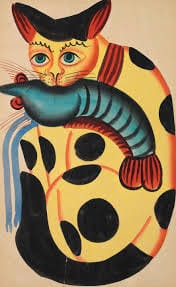Kalighat painting is a form of folk painting featuring bold, two-dimensional imagery, often depicting deities, mythological stories, and satirical social scenes. Originating in the 19th century near the Kalighat temple in Kolkata, Kalighat paintings were created by patuas (scroll painters) to depict religious themes for temple visitors.
Artists use handmade paper or cloth as the base. Outlines are drawn with a fine brush using bold black lines. Water-based colors are applied in flat tones with minimal shading. The finished painting often highlights key details like facial expressions and ornaments. These paintings are created by using natural pigments such as indigo, turmeric and soot on handmade paper or treated cloth. The brushes are made of animal hair.
Kalighat paintings are unique for their use of bold outlines and flat color application. Their depiction of simplified forms with exaggerated expressions and the use of minimal background for focus on central figures is also highly distinctive.





